Potential Prognostic Value of Native T1 in Pulmonary Hypertension Patients
Abstract
1. Introduction
2. Materials and Methods [10]
2.1. Subjects
2.1.1. Right Heart Catheterization
2.1.2. Classification
2.1.3. Clinical Data Collection
2.2. Cardiac MRI Data Acquisition [10]
2.3. Cardiac MRI Analysis [10]
2.3.1. Volumetric Measurements
2.3.2. Late Gadolinium Enhancement
2.3.3. Native T1 Mapping
2.4. Statistical Analysis
3. Results
3.1. Patient Characteristics
3.2. Volumetric Measurements
3.3. Late Gadolinium Enhancement
3.4. Native T1
3.5. Extracellular Volume Fraction
4. Discussion
5. Limitations [8,10]
6. Conclusions
Author Contributions
Funding
Institutional Review Board Statement
Informed Consent Statement
Data Availability Statement
Conflicts of Interest
References
- Bogaard, H.J.; Abe, K.; Vonk Noordegraaf, A.; Voelkel, N.F. The right ventricle under pressure: Cellular and molecular mechanisms of right-heart failure in pulmonary hypertension. Chest 2009, 135, 794–804. [Google Scholar] [CrossRef] [PubMed]
- Setaro, J.F.; Cleman, M.W.; Remetz, M.S. The right ventricle in disorders causing pulmonary venous hypertension. Cardiol. Clin. 1992, 10, 165–183. [Google Scholar] [CrossRef] [PubMed]
- Opitz, C.F.; Hoeper, M.M.; Gibbs, J.S.R.; Kaemmerer, H.; Pepke-Zaba, J.; Coghlan, J.G.; Scelsi, L.; D’Alto, M.; Olsson, K.M.; Ulrich, S.; et al. Pre-capillary, combined, and post-capillary pulmonary hypertension. J. Am. Coll. Cardiol. 2016, 68, 368–378. [Google Scholar] [CrossRef] [PubMed]
- Galiè, N.; Humbert, M.; Vachiery, J.-L.; Gibbs, S.; Lang, I.; Torbicki, A.; Simmonneau, G.; Peacock, A.; Vonk Noordegraaf, A.; Beghetti, M.; et al. 2015 ESC/ERS guidelines for the diagnosis and treatment of pulmonary hypertension: The joint task force for the diagnosis and treatment of pulmonary hypertension of the European society of cardiology (ESC) and the European respiratory society (ERS): Endorsed by: Association for European paediatric and congenital cardiology (AEPC), international society for heart and lung transplantation (ISHLT). Eur. Respir. J. 2015, 46, 903–975. [Google Scholar] [CrossRef]
- Guazzi, M.; Galiè, N. Pulmonary hypertension in left heart disease. Eur. Respir. Rev. 2012, 21, 338–346. [Google Scholar] [CrossRef]
- Assad, T.R.; Hemnes, A.R.; Larkin, E.K.; Glazer, A.M.; Xu, M.; Wells, Q.S.; Farber-Eger, E.H.; Sheng, Q.; Shyr, Y.; Harrel, F.E.; et al. Clinical and biological insights into combined post- and pre-capillary pulmonary hypertension. J. Am. Coll. Cardiol. 2016, 68, 2525–2536. [Google Scholar] [CrossRef] [PubMed]
- Habedank, D.; Obst, A.; Heine, A.; Stubbe, B.; Ewert, R. Correlation of hemodynamic and respiratory parameters in invasive cardiopulmonary Exercise Testing (iCPET). Life 2022, 12, 655. [Google Scholar] [CrossRef] [PubMed]
- Cerne, J.W.; Pathrose, A.; Gordon, D.Z.; Sarnari, R.; Veer, M.; Blaisdell, J.; Allen, B.D.; Avery, R.; Markl, M.; Ragin, A.; et al. Evaluation of pulmonary hypertension using 4D flow MRI. J. Magn. Reson. Imaging 2022, 56, 234–245. [Google Scholar] [CrossRef] [PubMed]
- Ruaro, B.; Salton, F.; Baratella, E.; Confalonieri, P.; Geri, P.; Pozzan, R.; Torregiani, C.; Bulla, R.; Confalonieri, M.; Matucci-Cerinic, M.; et al. An Overview of Different Techniques for Improving the Treatment of Pulmonary Hypertension Secondary in Systemic Sclerosis Patients. Diagnostics 2022, 12, 616. [Google Scholar] [CrossRef]
- Cerne, J.W.; Pathrose, A.; Sarnari, R.; Veer, M.; Chow, K.; Subedi, K.; Allen, B.D.; Avery, R.J.; Markl, M.; Carr, J.C. Left Ventricular Fibrosis Assessment by Native T1, ECV, and LGE in Pulmonary Hypertension Patients. Diagnostics 2023, 13, 71. [Google Scholar] [CrossRef]
- Wang, L.; Singh, H.; Mulyala, R.R.; Weber, J.; Barasch, E.; Cao, J.J. The association between left ventricular diastolic dysfunction and myocardial scar and their collective impact on all-cause mortality. J. Am. Soc. Echocardiogr. 2020, 33, 161–170. [Google Scholar] [CrossRef] [PubMed]
- Mousseaux, E.; Agoston-Coldea, L.; Marjanovic, Z.; Stanciu, R.; Deligny, C.; Perdrix, L.; Boutouyrie, P.; Azarine, A.; Soulat, G.; Farge, D. Left ventricle replacement fibrosis detected by CMR associated with cardiovascular events in systemic sclerosis patients. J. Am. Coll. Cardiol. 2018, 71, 703–705. [Google Scholar] [CrossRef] [PubMed]
- Chaikriangkrai, K.; Abbasi, M.A.; Sarnari, R.; Dolan, R.; Lee, D.; Anderson, A.S.; Ghafourian, K.; Khan, S.S.; Vorovich, E.E.; Rich, J.D.; et al. Prognostic value of myocardial extracellular volume fraction and T2-mapping in heart transplant patients. JACC Cardiovasc. Imaging 2020, 13, 1521–1530. [Google Scholar] [CrossRef] [PubMed]
- Asano, R.; Ogo, T.; Morita, Y.; Kotoku, A.; Aoki, T.; Hirakawa, K.; Nakayama, S.; Ueda, J.; Tsuji, A.; Waddingham, M.T.; et al. Prognostic value of right ventricular native T1 mapping in pulmonary arterial hypertension. PLoS ONE 2021, 16, e0260456. [Google Scholar] [CrossRef]
- De Lazzari, M.; Cipriani, A.; Rizzo, S.; Famoso, G.; Giorgi, B.; Tarantini, G.; Thiene, G.; Tona, F.; Iliceto, S.; Basso, C.; et al. Right ventricular junctional late gadolinium enhancement correlates with outcomes in pulmonary hypertension. JACC Cardiovasc. Imaging 2019, 12, 936–938. [Google Scholar] [CrossRef]
- Sandoval, J.; Bauerle, O.; Palomar, A.; Gómez, A.; Martínez-Guerra, M.L.; Beltrán, M.; Guerrero, M.L. Survival in primary pulmonary hypertension. Validation of a prognostic equation. Circulation 1994, 89, 1733–1744. [Google Scholar] [CrossRef]
- D’Alonzo, G.E. Survival in patients with primary pulmonary hypertension: Results from a national prospective registry. Ann. Int. Med. 1991, 115, 343–349. [Google Scholar] [CrossRef]
- McLaughlin, V.V.; Shillington, A.; Rich, S. Survival in primary pulmonary hypertension: The impact of epoprostenol therapy. Circulation 2002, 106, 1477–1482. [Google Scholar] [CrossRef]
- Simonneau, G.; Montani, D.; Celermajer, D.S.; Denton, C.P.; Gatzoulis, M.A.; Krowka, M.; Williams, P.G.; Souza, R. Haemodynamic definitions and updated clinical classification of pulmonary hypertension. Eur. Respir. J. 2019, 53, 1801913. [Google Scholar] [CrossRef]
- Rahsepar, A.A.; Ghasemiesfe, A.; Suwa, K.; Dolan, R.S.; Shehata, M.L.; Korell, M.J.; Naresh, N.K.; Markl, M.; Collins, J.D.; Carr, J.C. Comprehensive evaluation of macroscopic and microscopic myocardial fibrosis by cardiac MR: Intra-individual comparison of gadobutrol versus gadoterate meglumine. Eur. Radiol. 2019, 29, 4357–4367. [Google Scholar] [CrossRef]
- Florian, A.; Ludwig, A.; Rösch, S.; Yildiz, H.; Sechtem, U.; Yilmaz, A. Myocardial fibrosis imaging based on T1-mapping and extracellular volume fraction (ECV) measurement in muscular dystrophy patients: Diagnostic value compared with conventional late gadolinium enhancement (LGE) imaging. Eur. Heart J. Cardiovasc. Imaging 2014, 15, 1004–1012. [Google Scholar] [CrossRef] [PubMed]
- Lin, L.; Li, X.; Feng, J.; Shen, K.-N.; Tian, Z.; Sun, J.; Yue-ying, M.; Cao, J.; Zheng-yu, J.; Li, J.; et al. The prognostic value of T1 mapping and late gadolinium enhancement cardiovascular magnetic resonance imaging in patients with light chain amyloidosis. J. Cardiovasc. Magn. Reson. 2018, 20, 2. [Google Scholar] [CrossRef]
- Yang, E.Y.; Khan, M.A.; Graviss, E.A.; Nguyen, D.T.; Bhimaraj, A.; Nambi, V.; Hoogeveen, R.C.; Ballantyne, C.M.; Zoghbi, W.A.; Shah, D.J. Relationship of extracellular volume assessed on cardiac magnetic resonance and serum cardiac troponins and natriuretic peptides with heart failure outcomes. Sci. Rep. 2019, 9, 20168. [Google Scholar] [CrossRef] [PubMed]
- Saunders, L.C.; Johns, C.S.; Stewart, N.J.; Oram, C.J.E.; Capener, D.A.; Puntmann, V.O.; Elliot, C.A.; Condliffe, R.C.; Kiely, D.G.; Graves, M.F.; et al. Diagnostic and prognostic significance of cardiovascular magnetic resonance native myocardial T1 mapping in patients with pulmonary hypertension. J. Cardiovasc. Magn. Reson. 2018, 20, 78. [Google Scholar] [CrossRef]
- Reiter, U.; Reiter, G.; Kovacs, G.; Adelsmayr, G.; Greiser, A.; Olschewski, H.; Fuchsjäger, M. Native myocardial T1 mapping in pulmonary hypertension: Correlations with cardiac function and hemodynamics. Eur. Radiol. 2017, 27, 157–166. [Google Scholar] [CrossRef] [PubMed]
- Wong, T.C.; Piehler, K.; Meier, C.G.; Testa, S.M.; Klock, A.M.; Aneizi, A.A.; Shakesprere, J.; Kellman, P.; Shroff, S.G.; Schwartzman, D.S.; et al. Association between extracellular matrix expansion quantified by cardiovascular magnetic resonance and short-term mortality. Circulation 2012, 126, 1206–1216. [Google Scholar] [CrossRef]
- Kammerlander, A.A.; Marzluf, B.A.; Zotter-Tufaro, C.; Aschauer, S.; Duca, F.; Bachmann, A.; Knechtelsdorfer, K.; Wiesinger, M.; Pfaffenberger, S.; Greiser, A.; et al. T1 mapping by CMR imaging: From histological validation to clinical implication. JACC Cardiovasc. Imaging 2016, 9, 14–23. [Google Scholar] [CrossRef]
- Wong, T.C.; Piehler, K.M.; Kang, I.A.; Kadakkal, A.; Kellman, P.; Schwartzman, D.S.; Mulukutla, S.R.; Simon, M.A.; Shroff, S.G.; Kuller, L.H.; et al. Myocardial extracellular volume fraction quantified by cardiovascular magnetic resonance is increased in diabetes and associated with mortality and incident heart failure admission. Eur. Heart J. 2014, 35, 657–664. [Google Scholar] [CrossRef]
- Puntmann, V.O.; Carr-White, G.; Jabbour, A.; Yu, C.-Y.; Gebker, R.; Kelle, S.; Rolf, A.; Zitzmann, S.; Peker, E.; D’Angelo, T.; et al. Native T1 and ECV of noninfarcted myocardium and outcome in patients with coronary artery disease. J. Am. Coll. Cardiol. 2018, 71, 766–778. [Google Scholar] [CrossRef]
- Kato, S.; Nakamori, S.; Bellm, S.; Jang, J.; Basha, T.; Maron, M.; Manning, W.J.; Nezafat, R. Myocardial Native T1 Time in Patients With Hypertrophic Cardiomyopathy. Am. J. Cardiol. 2016, 118, 1057–1062. [Google Scholar] [CrossRef]
- Alunni, J.-P.; Degano, B.; Arnaud, C.; Tétu, L.; Blot-Soulétie, N.; Didier, A.; Otal, P.; Rousseau, H.; Chabbert, V. Cardiac MRI in pulmonary artery hypertension: Correlations between morphological and functional parameters and invasive measurements. Eur. Radiol. 2010, 20, 1149–1159. [Google Scholar] [CrossRef]
- Trip, P.; Rain, S.; Handoko, M.L.; van der Bruggen, C.; Bogaard, H.J.; Marcus, J.T.; Boonstra, A.; Westerhof, N.; Vonk-Noordegraaf, A.; de Man, F.S. Clinical relevance of right ventricular diastolic stiffness in pulmonary hypertension. Eur. Respir. J. 2015, 45, 1603–1612. [Google Scholar] [CrossRef] [PubMed]
- van Wolferen, S.A.; Marcus, J.T.; Boonstra, A.; Marques, K.M.J.; Bronzwaer, J.G.F.; Spreeuwenberg, M.D.; Postmus, P.E.; Vonk-Noordegraaf, A. Prognostic value of right ventricular mass, volume, and function in idiopathic pulmonary arterial hypertension. Eur. Heart J. 2007, 28, 1250–1257. [Google Scholar] [CrossRef] [PubMed]
- van de Veerdonk, M.C.; Kind, T.; Marcus, J.T.; Mauritz, G.-J.; Heymans, M.W.; Bogaard, H.-J.; Boonstra, A.; Marques, K.M.K.; Westerhof, N.; Vonk-Noordegraaf, A. Progressive right ventricular dysfunction in patients with pulmonary arterial hypertension responding to therapy. J. Am. Coll. Cardiol. 2011, 58, 2511–2519. [Google Scholar] [CrossRef]
- Strange, G.; Playford, D.; Stewart, S.; Deague, J.A.; Nelson, H.; Kent, A.; Gabbay, E. Pulmonary hypertension: Prevalence and mortality in the Armadale echocardiography cohort. Heart 2012, 8, 1805–1811. [Google Scholar] [CrossRef] [PubMed]
- Maron, B.A.; Brittain, E.L.; Hess, E.; Waldo, S.W.; Barón, A.E.; Huang, S.; Goldstein, R.H.; Assad, T.; Wertheim, B.W.; Alba, G.A.; et al. Pulmonary vascular resistance and clinical outcomes in patients with pulmonary hypertension: A retrospective cohort study. Lancet Respir. Med. 2020, 8, 873–884. [Google Scholar] [CrossRef]
- Corte, T.J.; Wort, S.J.; Gatzoulis, M.A.; Macdonald, P.; Hansell, D.M.; Wells, A.U. Pulmonary vascular resistance predicts early mortality in patients with diffuse fibrotic lung disease and suspected pulmonary hypertension. Thorax 2009, 64, 883–888. [Google Scholar] [CrossRef] [PubMed]
- Benza, R.L.; Miller, D.P.; Gomberg-Maitland, M.; Frantz, R.P.; Foreman, A.J.; Coffey, C.S.; Frost, A.; Barst, R.J.; Badesch, D.B.; Elliot, C.G.; et al. Predicting survival in pulmonary arterial hypertension: Insights from the Registry to Evaluate Early and Long-Term Pulmonary Arterial Hypertension Disease Management (REVEAL). Circulation 2010, 122, 164–172. [Google Scholar] [CrossRef]
- Spruijt, O.A.; Vissers, L.; Bogaard, H.-J.; Hofman, M.B.M.; Vonk-Noordegraaf, A.; Marcus, J.T. Increased native T1-values at the interventricular insertion regions in precapillary pulmonary hypertension. Int. J. Cardiovasc. Imaging 2016, 32, 451–459. [Google Scholar] [CrossRef]
- Vanderpool, R.R.; Pinsky, M.R.; Naeije, R.; Deible, C.; Kosaraju, V.; Bunner, C.; Mathier, M.A.; Lacomis, J.; Champion, H.C.; Simon, M.A. RV-pulmonary arterial coupling predicts outcome in patients referred for pulmonary hypertension. Heart 2015, 101, 37–43. [Google Scholar] [CrossRef]
- Humbert, M.; Kovacs, G.; Hoeper, M.M.; Badagliacca, R.; Berger, R.M.F.; Brida, M.; Carlsen, J.; Coats, A.J.S.; Escribano-Subias, P.; Ferrari, P.; et al. 2022 ESC/ERS Guidelines for the diagnosis and treatment of pulmonary hypertension: Developed by the task force for the diagnosis and treatment of pulmonary hypertension of the European Society of Cardiology (ESC) and the European Respiratory Society (ERS). Endorsed by the International Society for Heart and Lung Transplantation (ISHLT) and the European Reference Network on rare respiratory diseases (ERN-LUNG). Eur. Heart J. 2022, 43, 3618–3731. [Google Scholar] [CrossRef] [PubMed]
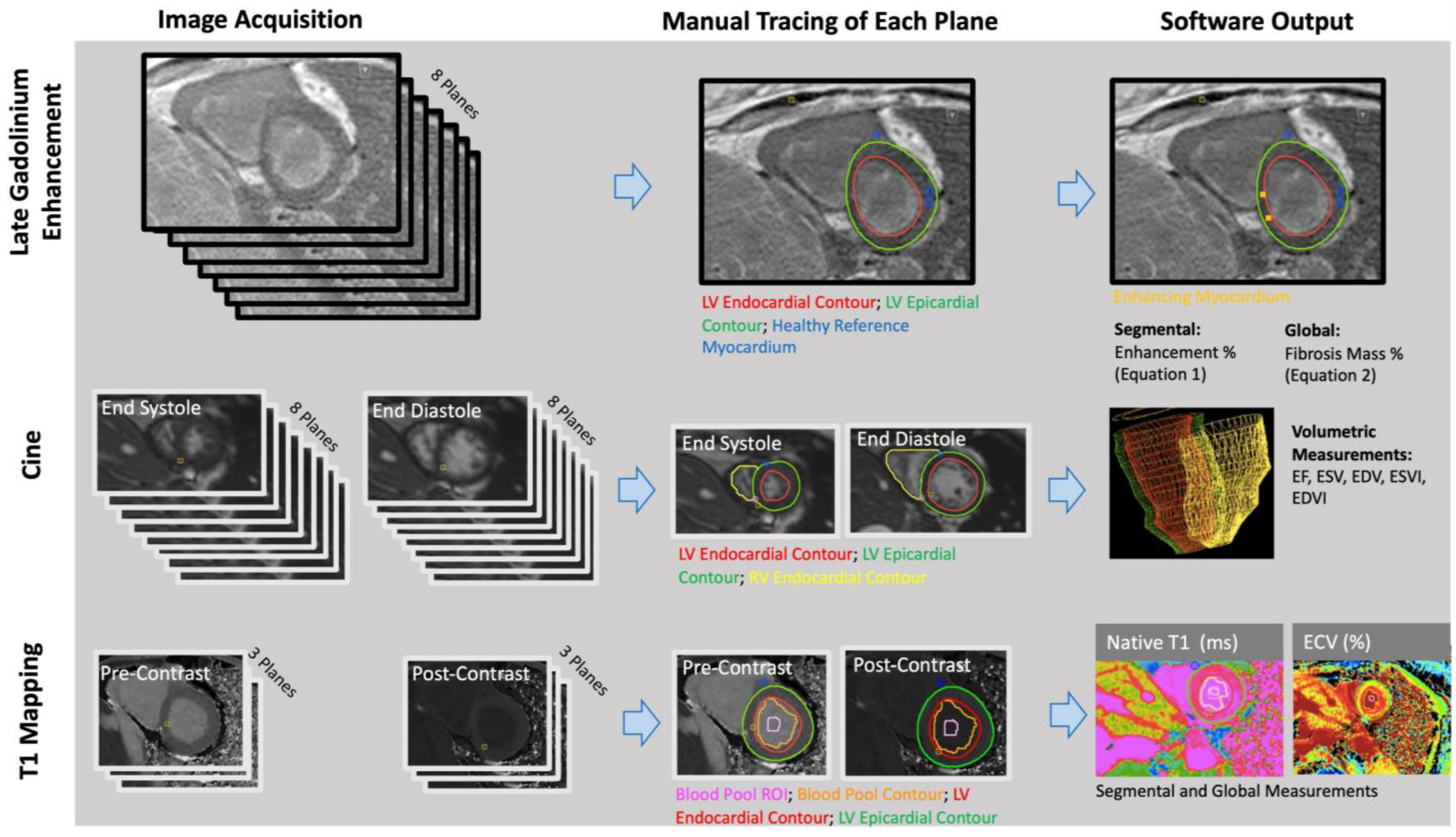
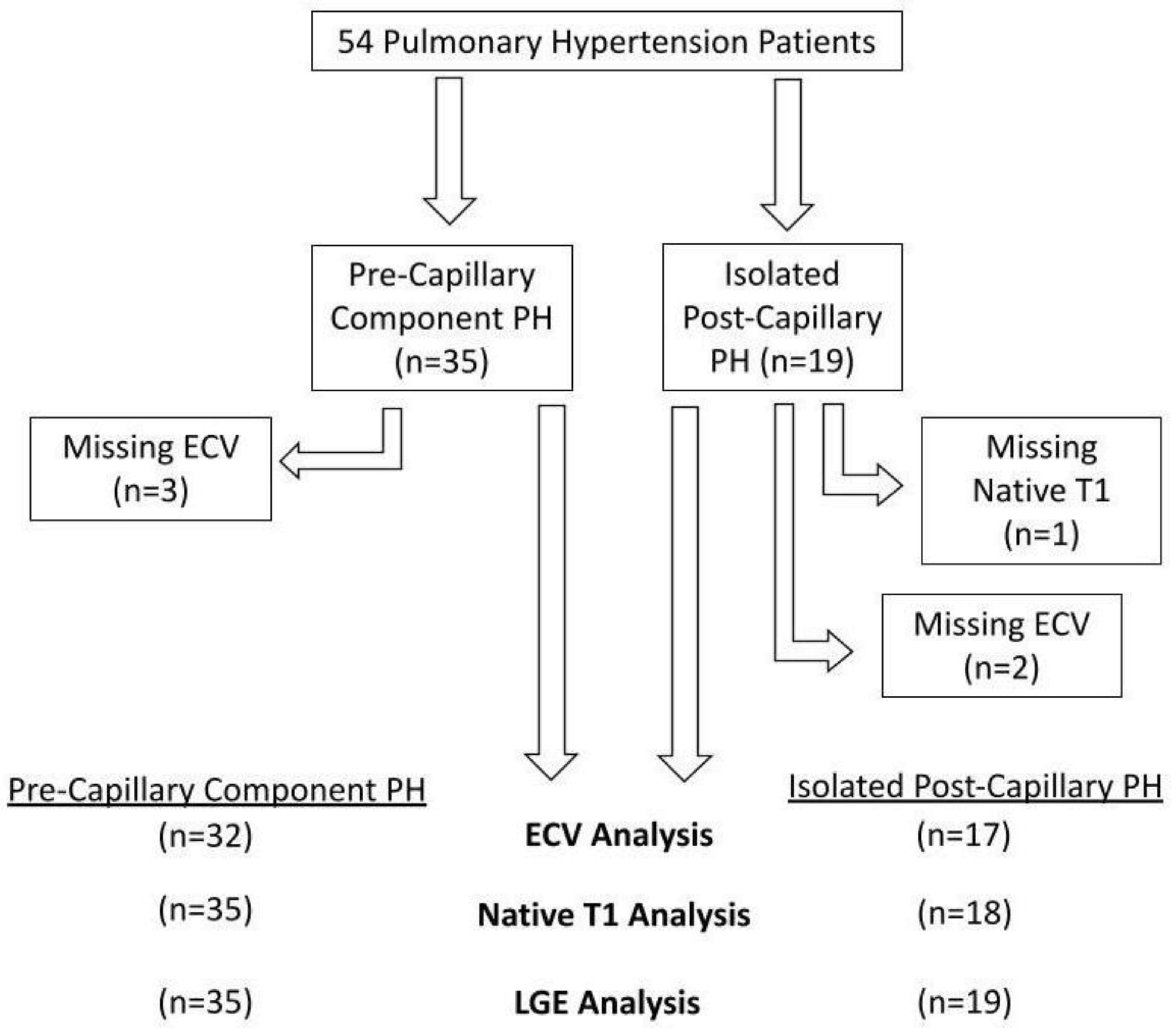
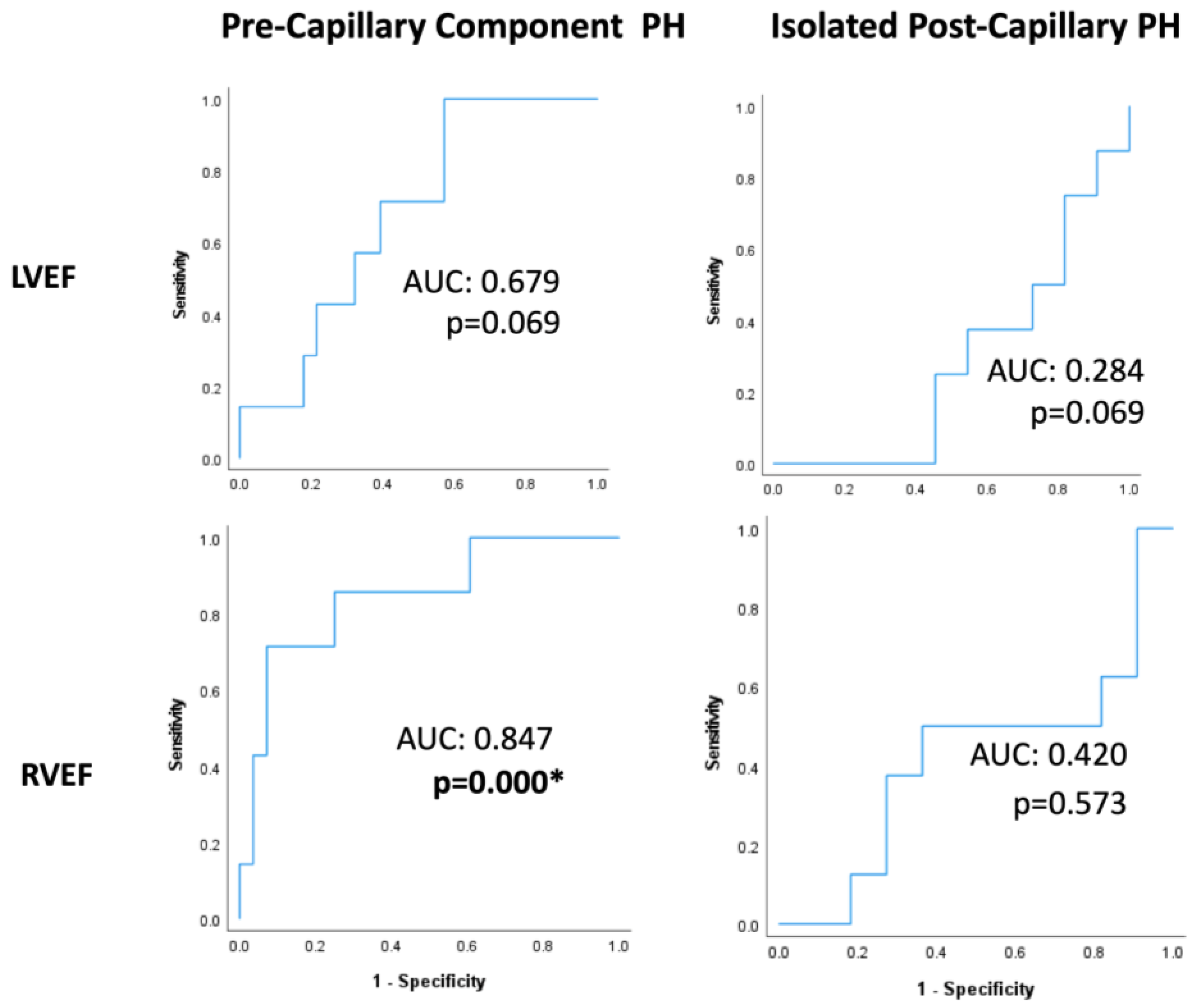
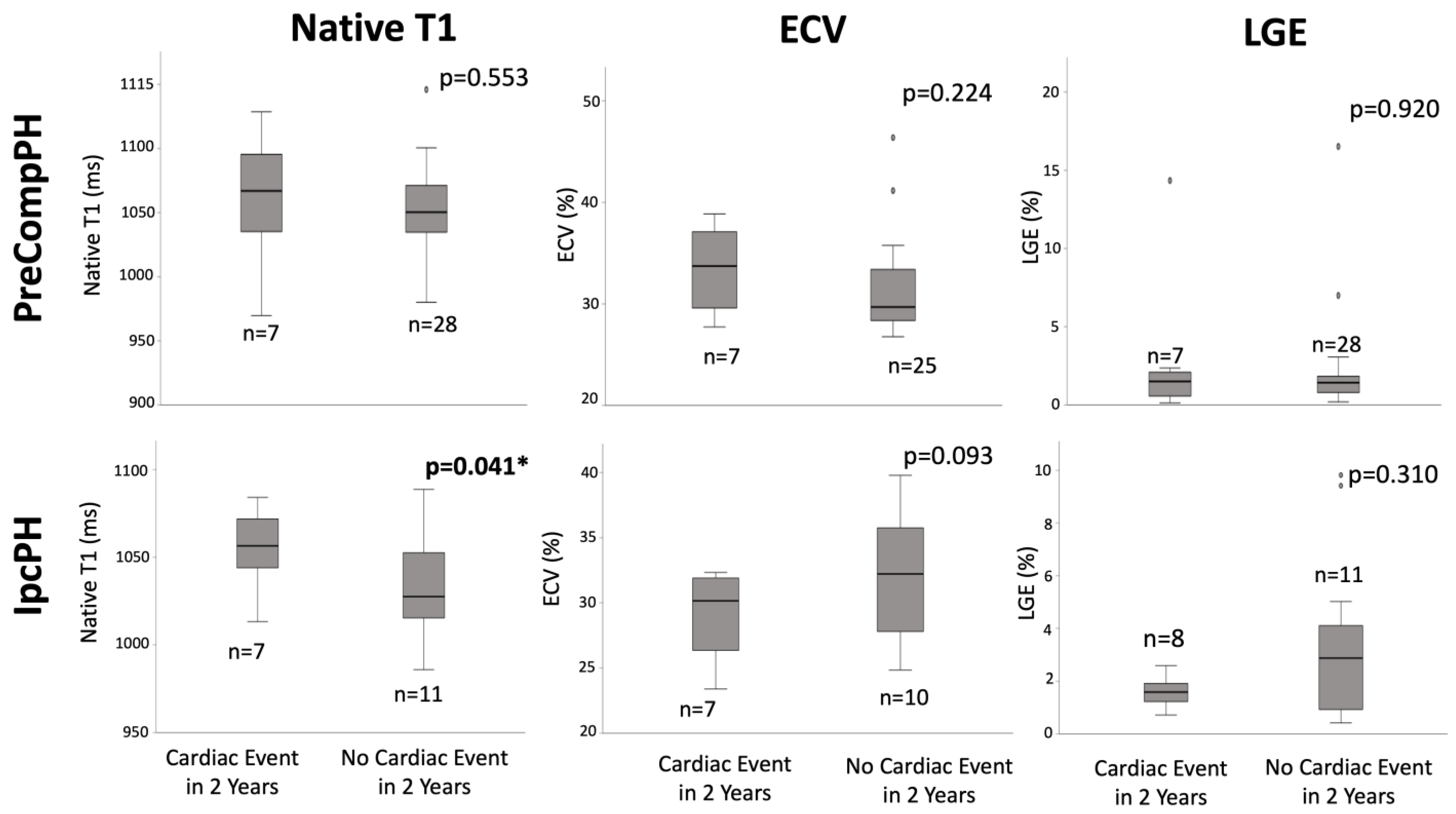

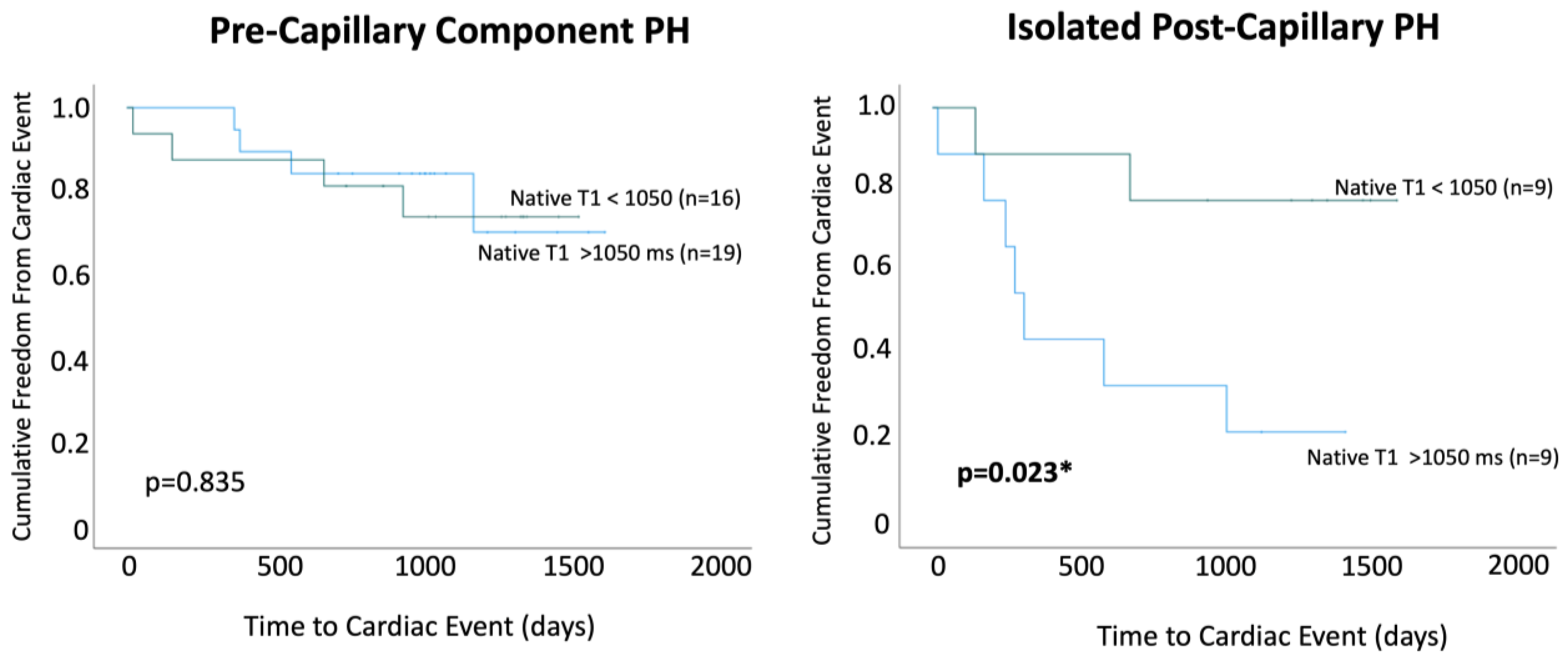
| Pre-Capillary Component PH | Isolated Post-Capillary PH | |||||
|---|---|---|---|---|---|---|
| Variables | Cardiac Event within 2 Years (n = 7) | No Cardiac Event within 2 Years (n = 28) | p-Value | Cardiac Event within 2 Years (n = 8) | No Cardiac Event within 2 Years (n = 11) | p-Value |
| Comorbidities | ||||||
| HLD | 3 (43%) | 10 (36%) | 1.000 | 3 (38%) | 5 (45%) | 1.000 |
| Smoking | 5 (71%) | 10 (36%) | 0.112 | 5 (63%) | 6 (54%) | 1.000 |
| Diabetes | 2 (29%) | 8 (29%) | 1.000 | 2 (25%) | 4 (36%) | 1.000 |
| HTN | 4 (57%) | 15 (54%) | 1.000 | 7 (88%) | 9 (82%) | 1.000 |
| Functional Status | ||||||
| NYHA Functional Class | - | 2.5 (1.5, 3.5) | - | 3 ± 0.7 | 3 (1, 2) | 0.343 |
| Six-Minute Walk Distance | - | 364 ± 57 | - | 429 ± 4.2 (only 2 values) | - | |
| BNP (pg/mL) | - | 193 ± 176 | - | 122 ± 72 | 515 ± 200 | 0.016 * |
| Clinical Status | ||||||
| Supplemental Oxygen | 3 (43%) | 12 (43%) | 1.000 | 0 | 0 | 1.000 |
| Peripheral Edema | 3 (43%) | 9 (32%) | 0.670 | 4 (50%) | 7 (64%) | 0.658 |
| Ascites | 0 | 2 (7%) | 1.000 | 1 (13%) | 2 (18%) | 1.000 |
| Variables | Area Under Curve (AUC) | p-Value |
|---|---|---|
| Fibrosis Measures | ||
| Native T1 | 0.587 | 0.558 |
| ECV | 0.632 | 0.273 |
| LGE | 0.478 | 0.876 |
| LV Volumetric Measures | ||
| LVEDV | 0.418 | 0.529 |
| LVESV | 0.500 | 1.000 |
| LVEDVI | 0.324 | 0.181 |
| LVESVI | 0.500 | 0.126 |
| LVEF | 0.679 | 0.069 |
| RV Volumetric Measures | ||
| RVEDV | 0.571 | 0.561 |
| RVESV | 0.648 | 0.236 |
| RVEDVI | 0.478 | 0.859 |
| RVESVI | 0.632 | 0.294 |
| RVEF | 0.847 | 0.000 * |
| Hemodynamic Measures | ||
| mPAP | 0.445 | 0.129 |
| PVR | 0.511 | 0.108 |
| Variables | Area Under Curve (AUC) | p-Value |
|---|---|---|
| Fibrosis Measures | ||
| Native T1 | 0.725 | 0.075 |
| ECV | 0.314 | 0.168 |
| LGE | 0.371 | 0.385 |
| LV Volumetric Measures | ||
| LVEDV | 0.386 | 0.424 |
| LVESV | 0.371 | 0.360 |
| LVEDVI | 0.443 | 0.694 |
| LVESVI | 0.429 | 0.624 |
| LVEF | 0.284 | 0.069 |
| RV Volumetric Measures | ||
| RVEDV | 0.414 | 0.552 |
| RVESV | 0.371 | 0.371 |
| RVEDVI | 0.429 | 0.643 |
| RVESVI | 0.429 | 0.650 |
| RVEF | 0.420 | 0.573 |
| Hemodynamic Measures | ||
| mPAP | 0.300 | 0.119 |
| PVR | 0.529 | 0.847 |
| Variables | Cardiac Event Occurred within 2 Years | No Cardiac Event Occurred within 2 Years | p-Value |
|---|---|---|---|
| Pre-Capillary Component PH | (n = 7) | (n = 28) | |
| LGE at No IPs | 1 (14%) | 9 (32%) | 0.645 |
| LGE at One IP | 6 (86%) | 17 (61%) | 0.380 |
| LGE at Both IPs | 0 | 2 (7%) | 1.000 |
| Isolated Post-Capillary PH | (n = 8) | (n = 11) | |
| LGE at No IPs | 5 (63%) | 7 (64%) | 1.000 |
| LGE at One IP | 1 (13%) | 4 (36%) | 0.338 |
| LGE at Both IPs | 2 (25%) | 0 | 0.164 |
Disclaimer/Publisher’s Note: The statements, opinions and data contained in all publications are solely those of the individual author(s) and contributor(s) and not of MDPI and/or the editor(s). MDPI and/or the editor(s) disclaim responsibility for any injury to people or property resulting from any ideas, methods, instructions or products referred to in the content. |
© 2023 by the authors. Licensee MDPI, Basel, Switzerland. This article is an open access article distributed under the terms and conditions of the Creative Commons Attribution (CC BY) license (https://creativecommons.org/licenses/by/4.0/).
Share and Cite
Cerne, J.W.; Shehata, C.; Ragin, A.; Pathrose, A.; Veer, M.; Subedi, K.; Allen, B.D.; Avery, R.J.; Markl, M.; Carr, J.C. Potential Prognostic Value of Native T1 in Pulmonary Hypertension Patients. Life 2023, 13, 775. https://doi.org/10.3390/life13030775
Cerne JW, Shehata C, Ragin A, Pathrose A, Veer M, Subedi K, Allen BD, Avery RJ, Markl M, Carr JC. Potential Prognostic Value of Native T1 in Pulmonary Hypertension Patients. Life. 2023; 13(3):775. https://doi.org/10.3390/life13030775
Chicago/Turabian StyleCerne, John W., Christina Shehata, Ann Ragin, Ashitha Pathrose, Manik Veer, Kamal Subedi, Bradley D. Allen, Ryan J. Avery, Michael Markl, and James C. Carr. 2023. "Potential Prognostic Value of Native T1 in Pulmonary Hypertension Patients" Life 13, no. 3: 775. https://doi.org/10.3390/life13030775
APA StyleCerne, J. W., Shehata, C., Ragin, A., Pathrose, A., Veer, M., Subedi, K., Allen, B. D., Avery, R. J., Markl, M., & Carr, J. C. (2023). Potential Prognostic Value of Native T1 in Pulmonary Hypertension Patients. Life, 13(3), 775. https://doi.org/10.3390/life13030775






